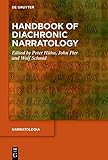Handbook of Diachronic Narratology / ed. by Peter Hühn, John Pier, Wolf Schmid.
Material type: TextSeries: Narratologia : Contributions to Narrative Theory ; 86Publisher: Berlin ; Boston : De Gruyter, [2023]Copyright date: ©2023Description: 1 online resource (VIII, 906 p.)Content type:
TextSeries: Narratologia : Contributions to Narrative Theory ; 86Publisher: Berlin ; Boston : De Gruyter, [2023]Copyright date: ©2023Description: 1 online resource (VIII, 906 p.)Content type: - 9783110616439
- 9783110616644
- 9783110617481
- online - DeGruyter
- Issued also in print.
| Item type | Current library | Call number | URL | Status | Notes | Barcode | |
|---|---|---|---|---|---|---|---|
 eBook
eBook
|
Biblioteca "Angelicum" Pont. Univ. S.Tommaso d'Aquino Nuvola online | online - DeGruyter (Browse shelf(Opens below)) | Online access | Not for loan (Accesso limitato) | Accesso per gli utenti autorizzati / Access for authorized users | (dgr)9783110617481 |
Frontmatter -- Contents -- Introduction: Towards a Diachronic Narratology -- Two Handbooks – Two Concepts? On “Diachronic” and “Historical” Narratology -- First-Person Narration in Ancient Greek and Modern English Literature -- Narrator as Dissociated from the Author in Russian Literature -- Narrator’s Commentary in Czech Literature (1300–1900) -- Characters and Persons in Russian Literature -- Unreliable Narration in Antiquity -- Point of View in Medieval and Early Modern German Literature -- Perspective in Narrative Texts of the European Middle Ages -- Point of View in Russian Literature -- Representing Mental States in Ancient Greek Narrative -- Free Indirect Discourse in German and Russian Literature -- Free Indirect Discourse in English (1200–1700) -- Free Indirect Discourse in English (1700–Present) -- Free Indirect Discourse in Medieval and Modern French Literature -- Interior Monologue in Ancient and Modern Literature -- The Rhetoric of Narration in the Early Modern Period -- Trajectories of Plot in Icelandic Literature -- Motivation in Medieval and Early Modern German Literature -- Temporality in Ancient and Medieval Literatures -- Cohesion and Coherence in Russian Narrative Literature -- Sequence in French, Italian, and Spanish Literature (1500–1800) -- Suspense in Greek, Latin, and Spanish Literature -- Suspense in Spanish Narratives from the Golden Age to the Nineteenth Century -- Ekphrasis in Ancient Greek and Latin Epics -- Mise en Abyme in the Baroque Era and in Modernist and Postmodernist Narrative Fiction -- Mise en Abyme in Russian Literature -- Eventfulness in Classical Greek and Latin Literature -- Eventfulness in Medieval and Early Modern English Literature -- Eventfulness in Medieval and Early Modern German Literature -- Eventfulness in Late Antique Jewish Literature -- Poetic Narratives: The Sonnet Sequence (1400–1900) -- Poetical Narration in Russian Literature from the Eighteenth Century to the Present -- Oral Storytelling in Ancient Greek and German Medieval Literature -- Metanarration and Self-Reflexivity in Classical Greek, Latin, and Byzantine Narrative -- A Diachronic Perspective on Metalepsis -- Metalepsis in English Literature: From the Middle Ages to Postmodernism -- Metalepsis in Czech Literature -- Narrative Metalepsis in German and Italian Literature of Medieval and Early Modern Age -- Fictionality and the Alterity of Premodern Literature -- Fictionality in Medieval and Early Modern German Literature -- Aesthetic Illusion: A History of ‘Immersion’ and Western Illusionist Literature since Antiquity -- List of Authors -- Index
restricted access online access with authorization star
http://purl.org/coar/access_right/c_16ec
This handbook brings together 42 contributions by leading narratologists devoted to the study of narrative devices in European literatures from antiquity to the present. Each entry examines the use of a specific narrative device in one or two national literatures across the ages, whether in successive or distant periods of time. Through the analysis of representative texts in a range of European languages, the authors compellingly trace the continuities and evolution of storytelling devices, as well as their culture-specific manifestations. In response to Monika Fludernik’s 2003 call for a "diachronization of narratology," this new handbook complements existing synchronic approaches that tend to be ahistorical in their outlook, and departs from postclassical narratologies that often prioritize thematic and ideological concerns. A new direction in narrative theory, diachronic narratology explores previously overlooked questions, from the evolution of free indirect speech from the Middle Ages to the present, to how changes in narrative sequence encoded the shift from a sacred to a secular worldview in early modern Romance literatures. An invaluable new resource for literary theorists, historians, comparatists, discourse analysts, and linguists.
Issued also in print.
Mode of access: Internet via World Wide Web.
In English.
Description based on online resource; title from PDF title page (publisher's Web site, viewed 25. Jun 2024)


